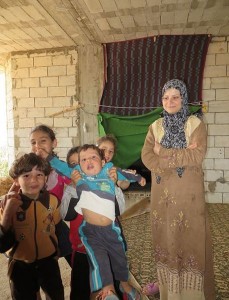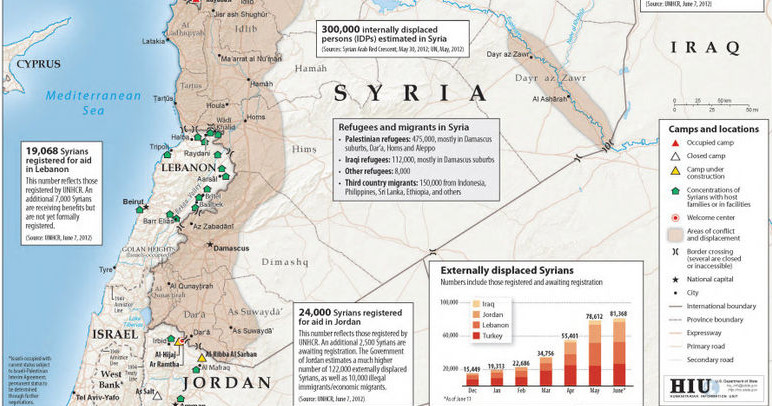 More than one million refugees have entered Lebanon since the beginning of the Syrian crisis in 2011, making up more than a quarter of Lebanon’s total population. According to Dr. Maha Shuayb from the Centre for Lebanese Studies, approximately 630,000 of these are children between three and 18 years old. At least 50,000 refugee children work 12 hours a day as the sole breadwinner for their families, while only 50 percent of all refugee children receive educational support. Syrian refugee children in particular face several social, economic and bureaucratic obstacles to continuing and often beginning their education.
More than one million refugees have entered Lebanon since the beginning of the Syrian crisis in 2011, making up more than a quarter of Lebanon’s total population. According to Dr. Maha Shuayb from the Centre for Lebanese Studies, approximately 630,000 of these are children between three and 18 years old. At least 50,000 refugee children work 12 hours a day as the sole breadwinner for their families, while only 50 percent of all refugee children receive educational support. Syrian refugee children in particular face several social, economic and bureaucratic obstacles to continuing and often beginning their education.
Aid distribution in Lebanon fluctuates drastically along the lines of sectarian division. Influential parties such as Michael Aoun’s officially secular but largely Christian ‘Free Patriotic Movement’ and Nasrallah’s shi’I ‘Hezbollah’ are strongly averse to the idea of permanent Syrian settlements due to both their fiercely nationalist ideologies and support for the Assad regime. The predominantly sunni, yet officially secular, ‘Future Movement,’ on the other hand, largely supports the establishment of permanent housing and identification cards as a way of integrating Syrian refugees into Lebanese civil society.
According to Foreign Minister Gebran Bassil, “all this aid encourages Syrian refugees to stay in Lebanon, while what we want is to encourage their speedy exit.” The integration of sunni Syrian refugees into Lebanese civil society is likely to further aggravate deep-rooted sectarian division and tilt political power in favor of the sunni population. The Lebanese constitution, drafted in 1926 when the Maronites were a clear majority, calls for a Maronite president, Sunni Prime Minister and a Shi’a speaker of the Parliament. Religious persecution during the 1860 Druze-Maronite conflict in Ottoman Syria, the 1958 Lebanese Civil War and the very recent rise of a nationalist ‘Islamic identity,’ have created a massive global diaspora with more Lebanese living abroad than in Lebanon. Potential political imbalance, caused by the influx of sunni Muslims, coupled with a limiting of funds dedicated to Lebanese national affairs, has fostered resentment within the Lebanese government and general population.Schisms have already formed along the lines of national identity. Refugees from Syria are actually divided into Syrian nationals and Palestinian refugees who were previously seeking refuge in Syria. Due to years of Palestinian displacement, Lebanon has been able to construct the legal infrastructure necessary to maintain UNRWA run educational facilities. According to MERIP, PRS are “double refugees who qualify for services under UNRWA’s pre-existing aid infrastructure in Lebanon.” Subsequently, Lebanese educational facilities are intended solely for Palestinian ‘nationals’ (a phenomenon that partially indicates the normalization of Palestinian refugee status). Syrian refugee children face more immediate obstacles of discrimination, family realities and language.
According to a Syrian mother, her child, Mazin, was “humiliated and beaten” at a Lebanese public school. The dropout rate at Lebanese public schools has increased to 70 percent, thus forcing Syrian refugee children to either pay tuition at private facilities or attend unofficial programs run by NGOs, mainly UNRWA, deepening the divide between the Syrian and Palestinian refugee populations. UNRWA schools are currently facing severe pressure from the international community to admit Syrian refugees along with the Palestinian refugees from Syria. The overwhelming number of children attending these limited schools, however, has caused their quality to decline. They are currently considered the “most underperforming schools in Lebanon.” Attending unofficial NGO-run schools is thus a solution that addresses educational necessities with the same expectant temporariness of the Syrian refugee influx. If Syrian children are to receive a comprehensive education, social infrastructure needs to be built on the basis of stability and, subsequently, sustainability. The Lebanese government, however, is reluctant to establish sustainable infrastructure supporting the permanent residence of Syrian refugees in fear of exacerbating sectarian divisions and perpetuating the nation’s current economic slowdown. Alternatively, Jad Chaaban, professor of economics at the American University of Beirut has argued that the Lebanese media’s focus on the negative impacts of Syrian refugees is exaggerated, implying ethnic and sectarian balance as the actual primary concern.
Language poses a significant obstacle to the education of Syrian refugee children. The Syrian school system is run solely in Arabic, while the Lebanese school system is trilingual with English and French used as languages of instruction for math and science. According to a recent assessment by Save the Children and UNICEF, Syrian children are being placed in lower grades than the ones they originally attended in Syria. Furthermore, several refugee children have been out of school since the beginning of the Syrian conflict and are working to support their families. Mohammed earns less than 10,000 Lebanese pounds, roughly equivalent to 6 US dollars, a day roaming the streets of Beirut’s Hamra shopping district — an insufficient wage for an entire family considering the fact that the cost of living in Beirut is similar to that in Los Angeles. When asked if he’d like to return to school, Mohammed replied, “Inshallah, when I return to Syria.”Legal and financial barriers also hamper Syrian refugee children’s access to education. Many refugee parents are “afraid to let their children travel longer distances to school,” while others cannot afford an extra 100,000 Lebanese pounds dedicated toward travel. Lebanese officials also demand formal documents for enrollment in 9th and 10th Grade Final Exams. Few people think of taking such papers when fleeing their homes and most expect to return soon. The Lebanese government has suggested that Syrian refugees approach the Syrian Embassy in Lebanon to acquire the relevant documents, yet many fear retribution from the Assad regime. Additionally, several Syrian refugees cross the border illegally and therefore have no documented presence in Lebanon. The Ministry of Education has issued a decree that allows admittance to school despite the legal status of a child, yet individual principals choose not to follow this decree in fear of potential repercussions in Lebanon’s highly divided and politically spontaneous society.
As the crisis in Syria escalates, the Lebanese government continues to place further restrictions on aid distribution. Foreign Minister Gebran Bassil’s xenophobic rhetoric reflects the fearful sentiment articulated by Nayla Tueni, one of Lebanon’s two youngest Parliament members, that refugees from Syria “will lead us to finding ourselves facing a new reality, and new settlers, and a new burden, returning to our memories of the Palestinian nightmare in 1970” – a statement deemed “racist” by Sawsan Abdulrahim in the Jadaliyya article, “An Open Letter to Lebanese MP Nayla Tueni.”
The marginalization of Syrian refugees has hindered access to education and intensified the neglect of refugee children. Social, economic and bureaucratic obstacles stemming from Lebanon’s deeply divided sectarian society and past experiences with Palestinian refugee influx have created mixed policy proposals regarding the general future of Syrian refugees in Lebanon and the specific establishment of schools tailored for Syrian refugee children.
The existing framework, or lack of, represents current inter-sectarian confusion, and has only invited more Syrians seeking refuge. According to Dr. Maya Shuayb, and contrary to Gebran Bassil, the Lebanese government’s refusal to build official camps until very recently has merely encouraged Syrian refugees, who feel they are able to move more freely in Lebanon beyond the confines of Jordan’s contained camp parameters. Lebanon’s refusal to legislate policy concerning the long-term presence of Syrian refugees has therefore counter-intuitively contributed to an increase in short-term influx. This inevitability, given the intensifying Syrian civil war, highlights the need to draft long-term policy frameworks concerning Syrian refugee welfare regardless of the government’s fear of permanent refugee settlements.
